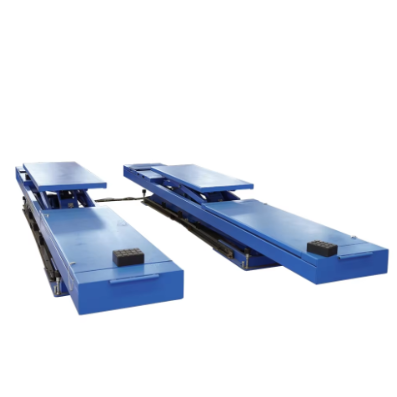Enhancing Safety and Precision in Vehicle Restoration
Stable Platform for Detailed Underbody Work
Having something stable to stand on makes all the difference when working underneath cars. That's where car lifts come in handy, giving mechanics good access to get inside and check everything properly. Most modern lifts have those safety straps and locks built in, which keeps everyone safer while they're doing the nitty gritty stuff. The Automotive Lift Institute actually reports that around 25% of injuries in auto repair shops happen because workers are dealing with unstable platforms. Makes sense why solid equipment matters so much. Another plus? Technicians can maintain better body positions when using lifts, which means they see what they're doing clearer and have more control over their repairs without straining themselves unnecessarily.
Reducing Physical Strain During Long Projects
Car lifts make a big difference when it comes to cutting down on physical strain, especially for those tackling lengthy car restoration jobs. They take away the constant need to bend over and stretch awkwardly, which means fewer injuries down the road. Research shows mechanics who work with lifts report about 40 percent less physical stress than their counterparts stuck working flat on the floor all day. When restorations are planned properly around lift usage, the whole workflow gets smoother and workers can actually stay at their benches longer without feeling sore. Good quality lifts that pay attention to ergonomics let techs keep their bodies in more natural positions while they work, so they don't get as tired and can crank out better results even after spending hours under the hood.
Optimizing Workspace Efficiency with Car Lifts
Maximizing Vertical Space in Home Garages
One major benefit of putting car lifts in home garages comes down to making better use of vertical space. These lifts let owners fit multiple cars into what would otherwise be one parking spot, no need to expand the garage itself. According to industry data, garage lifts can actually turn a standard home garage into twice as much usable area. Cleaner workspace means fewer tripping hazards and tools lying around everywhere, which makes working on cars way easier than trying to maneuver around clutter. And when picking out a lift model, taller ones work best for folks who own SUVs or trucks, so they get maximum value from their investment without wasting precious floor space.
Multi-Vehicle Storage Solutions
For people who collect cars but live in smaller spaces, car lifts offer real solutions when it comes to keeping multiple vehicles stored properly. Many folks working on their properties or fixing things around the house will tell anyone who'll listen about how a good four post lift makes all the difference in organizing those precious wheels inside where they're safe from weather damage. When vehicles are lifted off the ground, suddenly there's room down below for storing all sorts of stuff nobody wants cluttering up valuable garage space - think spare tires, jack stands, oil cans, wrench sets, whatever mechanics need within reach. Switching over to this kind of storage system means getting better access to each car without having to push them around like bumper cars in a crowded parking lot. Makes sense especially if the garage isn't huge to begin with, right? Just ask anyone who's ever tried to work on two different projects at once while dodging parked cars!
Key Features of Car Lifts for Restoration Projects
Adjustable Height Settings for Custom Access
Adjustable height car lifts give mechanics and restorers the ability to set their lift exactly where needed, something pretty important when dealing with all sorts of vehicles and different kinds of repairs. Classic car restoration projects really benefit from this feature since older models typically require certain spots to be accessed properly for good quality work. Garage owners I've talked to mention that lifts capable of moving through a broad range of heights make their shops much more versatile, opening up possibilities for all sorts of projects big and small. These adjustable features let workers take accurate measurements and make necessary tweaks, which boosts overall accuracy without compromising on safety standards in the workshop. Getting the right height for each job means technicians spend less time struggling underneath cars and more time actually doing the restoration work safely.
Weight Capacity Considerations for Classic Cars
Knowing what weight limit a car lift can handle matters a lot, especially when working on those heavy classic cars. Take vintage muscle cars for instance they tend to pack on extra pounds compared to today's lighter models. That means classic car enthusiasts need to double check their lift specs before getting started. Standard garage lifts usually work fine for everyday vehicles but won't cut it for older models without proper verification. According to industry guidelines, anything below 3,000 pounds probably isn't going to be enough for most classic restorations. When looking at different lift options, restorers should consider not just weight capacity but also how well the design suits their particular workshop setup. After all, nobody wants to deal with equipment failure mid-project when hundreds of hours have already gone into bringing an old beauty back to life.
Maintenance Best Practices for Long-Term Reliability
Regular Hydraulic System Inspections
Checking the hydraulic system on a regular basis is really important when it comes to keeping automotive lifts running properly. These checks help spot any possible leaks before they become big problems and keep everything working efficiently. Most technicians recommend doing these inspections every three months or so to stop wear and tear from getting too bad and actually prolong how long the lift will last. Keeping the fluid at the right level matters a lot too, along with looking closely at all those connection points. This helps save money down the road by preventing expensive fixes later on while making sure the equipment performs reliably day after day. Writing down what gets noticed during each inspection creates something useful for planning future maintenance work and knowing where to focus attention next time around. When shops stick to good maintenance habits for their hydraulics, everyone stays safer at work and the lifts continue to do their job without letting anyone down.
Lubrication and Safety Lock Testing
Keeping moving parts well lubricated helps cut down on friction and wear, which means automotive lifts last longer overall. Safety locks need regular checking too so we know they actually work when needed, something that keeps everyone safe while using these machines. Mechanics should keep track of when they applied lubricant and tested those safety mechanisms. A good logbook makes it easier to spot trends in maintenance needs over time. When problems get caught early through this kind of monitoring, things run smoother day to day at the shop. Shops that make time for proper lubrication routines and frequent safety checks tend to have fewer breakdowns and happier customers who feel confident about their safety around heavy equipment.
Choosing the Right Car Lift for Restoration Needs
Two-Post vs. Four-Post Lifts: Pros and Cons
When deciding between two post and four post lifts for restoration work, it really comes down to what fits best with the particular job at hand. Two post models give good access underneath cars which makes them great choices for smaller shops where floor space matters since they take up less room overall. Four post versions provide much better stability when parking vehicles overnight or storing heavier machinery safely without worrying about tipping over. Most mechanics find themselves picking based on several things including type of repairs needed, available funds, and how big the shop actually is. Taking all these elements into account helps narrow down options until finding something practical becomes possible.
Portable Options for Flexible Workspaces
Portable lifts bring real advantages to anyone needing flexibility at work. Great for folks running out of home garages or mobile repair shops, these units let technicians haul equipment right where jobs need it. They're light enough to move around yet sturdy enough for serious work, plus they tuck away easily when sitting idle. Industry reports show rising interest in portable lift systems, with many auto restorers finding them indispensable across different job locations. With more people seeking adaptable workspace options, portable lifts keep gaining traction as both practical and cost-effective investments for workshop owners looking to stay competitive.
FAQ
Why are stable platforms important for vehicle restoration?
Stable platforms, such as car lifts, are important for vehicle restoration as they provide secure access for inspections and repairs, improving safety and ergonomics for technicians.
How do car lifts help reduce physical strain?
Car lifts reduce physical strain by allowing mechanics to work in ergonomic postures and reducing the need for excessive bending and stretching during vehicle restoration projects.
What are the benefits of maximizing vertical space with car lifts?
Maximizing vertical space with car lifts allows for more vehicle storage without increasing garage dimensions, leading to a more organized and productive workspace.
How can car lifts enhance multi-vehicle storage?
Car lifts enhance multi-vehicle storage by organizing and securing vehicle collections indoors, creating more floor space for additional storage, and improving accessibility.

